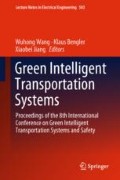Abstract
Based on the previous studies, the characteristics of VSP distribution of heavy-duty diesel vehicles and their impacts due to varying highway grades, as well as velocity factors measured on a mountainous highway in China were investigated. Data were collected using a CAN Bus adapter and a car video recorder mounted on the test vehicles. Statistical distribution models with a scope of bins are established and identified through a goodness of fit test approach by using the sample data. Finally, the model was verified through a goodness of fit testing approach by using a portion of data collected from the mountainous highway. Relative errors between fuel consumption estimates and actual fuel use were generally under 10%, which verifies the reliability and effectiveness of VSP distribution model for heavy-duty diesel vehicles for the mountainous highway.
Access this chapter
Tax calculation will be finalised at checkout
Purchases are for personal use only
References
Jiménez-Palacios JL (1999) Understanding and quantifying motor vehicle emissions with vehicle specific power and TILDAS remote sensing. Massachusetts Institute of Technology
Zhuo Y, Heng W, Hao L et al. (2013) Statistical vehicle specific power profiling for urban freeways. Soc Behav Sci 98:2927–2938
Frey HC, Rouphail NM, Zhai H (2006) Speed and facility-specific emission estimates for on-road light-duty vehicles on the basis of real-world speed profiles. Transp Res Rec J Transp Res Board 1987(1):128–137
Song G, Yu L, Tu Z (2015) Distribution characteristics of vehicle-specific power on urban restricted-access roadways. J Transp Eng 138(2):202–209
Zang KS, Frey HC (2005) Road grade estimation for on-road vehicle emissions modeling using LIDAR data. In: Proceedings of Annual Meeting of the Air & Waste Management Association
Sandberg T (2009) Heavy truck modeling for fuel consumption simulations and measurements. J Linkop Stud Inence Technol Thesis 2002:924
Song GH, Yu L (2009) Estimation of fuel efficiency of road traffic by characterization of vehicle-specific power and speed based on floating car data. Transp Res Rec J Transp Res Board 2139(2):11–20
Barth M, Younglove T, Scora G (2005) Development of a heavy-duty diesel modal emissions and fuel consumption model. California Partners for Advanced Transportation Technology
Frey HC, Unal A, Chen J, Li S, Xuan C (2002) Methodology for developing modal emission rates for EPA’s multi-scale motor vehicle and equipment emission system. Publication EPA420-R-02-027
Motor vehicle emission simulator (MOVES) (2014) User guide. Environmental Protection Agency, U.S, p 2015
IVE Model Users Mannual (Version 2.0) (2008). University of California at Riverside
Nam EK, Giannelli R (2005) Fuel consumption modeling of conventional and advanced technology-y vehicles in the physical emission rate estimator (PERE). Draft Report EPA420-P-05-001. U.S. Environmental Protection Agency
Song G, Yu L, Zhang Y (2012) Applicability of traffic micro-simulation models in vehicle emission estimations: a case study of VISSIM. The 91st Annual Meeting of the Transportation Research Board, Washington, D.C.
Frey HC, Rouphail NM, Zhai H et al (2007) Comparing real-world fuel consumption for diesel- and hydrogen-fueled transit buses and implication for emissions. Transp Res Part D Transp Environ 12(4):281–291
Younglove T, Scora G, Barth M (2005) Designing on-road vehicle test programs for the development of effective vehicle emission models. Transp Res Rec 1941:47–56
Barth M, Malcolm C, Younglove T et al (2001) Recent validation efforts for a comprehensive modal emissions model. Transp Res Rec: J Transp Res Board 1750:13–23
Author information
Authors and Affiliations
Corresponding author
Editor information
Editors and Affiliations
Rights and permissions
Copyright information
© 2019 Springer Nature Singapore Pte Ltd.
About this paper
Cite this paper
Chen, T., Li, Mx., Feng, Hj., Chen, B., Gao, Y. (2019). Statistical Vehicle Specific Power Profiling of Heavy-Duty Vehicles for Mountainous Highways. In: Wang, W., Bengler, K., Jiang, X. (eds) Green Intelligent Transportation Systems. GITSS 2017. Lecture Notes in Electrical Engineering, vol 503. Springer, Singapore. https://doi.org/10.1007/978-981-13-0302-9_23
Download citation
DOI: https://doi.org/10.1007/978-981-13-0302-9_23
Published:
Publisher Name: Springer, Singapore
Print ISBN: 978-981-13-0301-2
Online ISBN: 978-981-13-0302-9
eBook Packages: EngineeringEngineering (R0)

